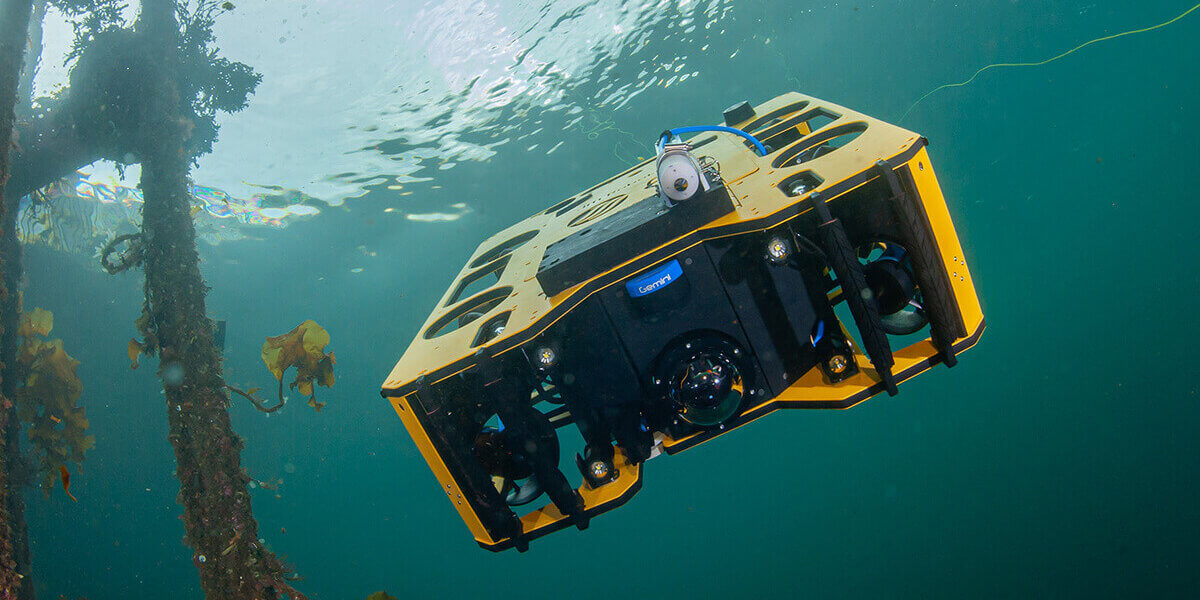
Underwater vehicle built with Blue Robotics technology by a partner in Norway [PHOTO COURTESY OF JM ROBOTICS]
For Jehangir (B.S. ME’ 11, M.S. AE ’13), an alumnus of the USC Viterbi School of Engineering, and his experienced engineer friends, this didn’t seem all that complicated. They would just need to collect solar panels, a GPS, a microcontroller, satellite radio and a thruster. However, they soon realized that finding a durable, efficient, and affordable thruster was a lot more difficult than they thought.
Without the right thruster, the SolarSurfer couldn’t propel forward. After scouring the internet for options, they realized the only ones available were military-grade industrial thrusters that cost upwards of $1,000 each or made-from-scratch models that wouldn’t last more than a couple hours underwater. Neither option was appealing.
The SolarSurfer didn’t make it to Hawaii. That disappointment sparked Jehangir’s next big realization: If military-grade and homemade thrusters are the only options, then what are hobbyists, student robotics teams, researchers, explorers, and maritime companies using? What if he built cheaper thrusters that would allow this neglected market to develop reasonably priced underwater robots?
With so much of the ocean hidden from humanity, Jehangir was growing interested in these smaller-scale, remotely operated vehicles that could enable ocean exploration at a much more accessible and approachable price point.
“We realized there was this gaping hole in the middle of the market,” Jehangir said.
“It was mind-blowing because it seemed like somebody should be doing this, but nobody was doing it.”
He filled his garage with tools, a drill press, and a 3-D printer; he started prototyping. It took six months, but Jehangir landed at the same thruster design that his company still uses nine years later.
On Aug. 11, 2014, he launched a Kickstarter campaign that raised $100,000 and sold 600 thrusters—right from his garage. And that was the start of Blue Robotics.
WHAT IS BLUE ROBOTICS?
Starting with the T100 thruster nine years ago, Blue Robotics now boasts a selection of over 350 products that can be used for building underwater robots. With affordable pricing and high quality, Jehangir said Blue Robotics caters to a wide audience, from competitive high school robotics teams across the U.S. to aquaculture farms in Norway, Chile, New Zealand, and Mexico.
Jehangir took an unconventional approach to designing his thrusters. Normally, an underwater thruster is made from a regular electric motor that’s placed into a sealed tube to protect it from the water, and a magnetic coupling transfers the rotation to the propeller on the outside. It’s difficult and expensive to build but the industry standard.
Instead of trying to protect the motor from the water, Blue Robotics built a waterproof motor. They replaced the steel ball bearings with plastic ones and coated all the electric windings and magnets to prevent corrosion. Essentially, the thruster was one moving part that was now much smaller, inexpensive, and required less maintenance. By dramatically reducing production costs, they could offer high quality thrusters for $100, which was significantly cheaper than existing options on the market.
“I’m glad I was young at the time. I didn’t have any experience in marine robotics, which is actually what allowed me to design the thrusters the way I did,” Jehangir said “Blue Robotics thrusters tried out something new, but it would have been hard to do without coming in with a blank slate and a naively optimistic impression of what I could do.”
RUSTY’S BACKGROUND
After earning his USC Viterbi master’s degree in aerospace engineering, Jehangir jumped straight into the startup world, where he helped develop a new helicopter for the U.S. military.
This was where he got his first taste of entrepreneurship: prototyping, hiring and firing team members, raising money, as well as learning more about electrical and software engineering.
“I feel like I got a crash course in business and engineering,” said Jehangir. “Eventually when I left, I had gotten the entrepreneurial bug and wanted start something myself.”
For Jehangir, leading a weekly team meeting as the founder of Blue Robotics gives the trombone player the same feeling as performing an improvisational jazz piece as part of the Thornton Jazz Orchestra: a rush of adrenaline and creativity that he can share with others.
Jehangir came to USC as a multifaceted student double majoring in mechanical engineering and jazz music in 2007. He said that USC’s support for pursuing majors in two totally different fields drew him to the university.
“Eventually, I realized engineering was way more exciting to me, but my history with music definitely made a lasting impact on me,” he said.
At USC Viterbi, he served as president of the undergraduate aerial robotics team, where he was exposed to many of the technologies he currently uses. He also gained experience in leading people.
“Running a company requires you to be a problem-solver and a performer. I have to present my ideas to the team and talk at conferences all the time,” Jehangir said. “At the end of the day, I’m still an introvert, but it helps being familiar with the feeling of performing. It reminds me of when I used to improvise on stage.”
BLUE ROBOTICS NOW
![The Blue Robotics team [PHOTO COURTESY OF BLUE ROBOTICS]](https://viterbischool.usc.edu/wp-content/uploads/2023/10/bluerobotics-e1697485723934-300x150.jpeg)
The Blue Robotics team [PHOTO COURTESY OF BLUE ROBOTICS]
Customers come from a wide variety of industries and countries.
Currently, Blue Robotics is heavily involved in the aquaculture industry. Norway, with its booming aquaculture industry, is a major importer of the company’s thrusters.
Blue Robotics products are used with underwater equipment that inspect nets, anchors, and chains used in the salmon farms. Additionally, Jehangir added, the company’s thrusters have appeared in an art exhibition in Germany and have been used to power underwater cameras for Shark Week and National Geographic’s shipwreck discovery documentaries.
However, Jehangir’s favorite customers are student-run underwater robotics teams.
“We definitely have a soft spot for high school and college competitions,” he said. “We sponsor these competitions and give prizes. It’s super important to us because not only are these students are customers, but they’re also the future of our industry.”
FUTURE OF INDUSTRY AND BLUE ROBOTICS
Jehangir is excited for the slow-yet-steady growth of the underwater robotics industry. With the rising interest in the ocean and climate change research and solutions, he hopes that Blue Robotics can continue to provide the underlying materials to enable underwater exploration.
As for his work with Blue Robotics, Jehangir hopes to continue growing the company along with the industry.
“In the startup world, it seems that everybody dreams of a grand exit. But as I’ve gotten older and dived deeper into Blue Robotics, I realize I’m in a really lucky spot where I love what I’m doing, who I’m doing it with, and who I’m doing it for,” he said. “I think there’s tons of room in this industry because it’s still small, but the ocean is huge. The best way to explore it is through robotics.”
Published on October 31st, 2023
Last updated on October 31st, 2023












